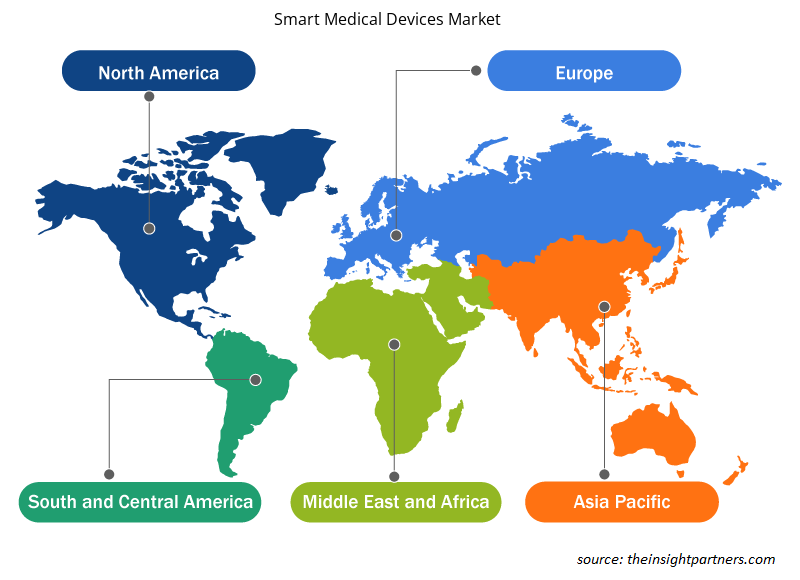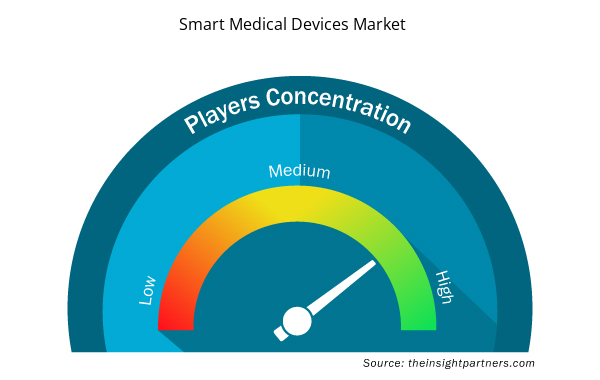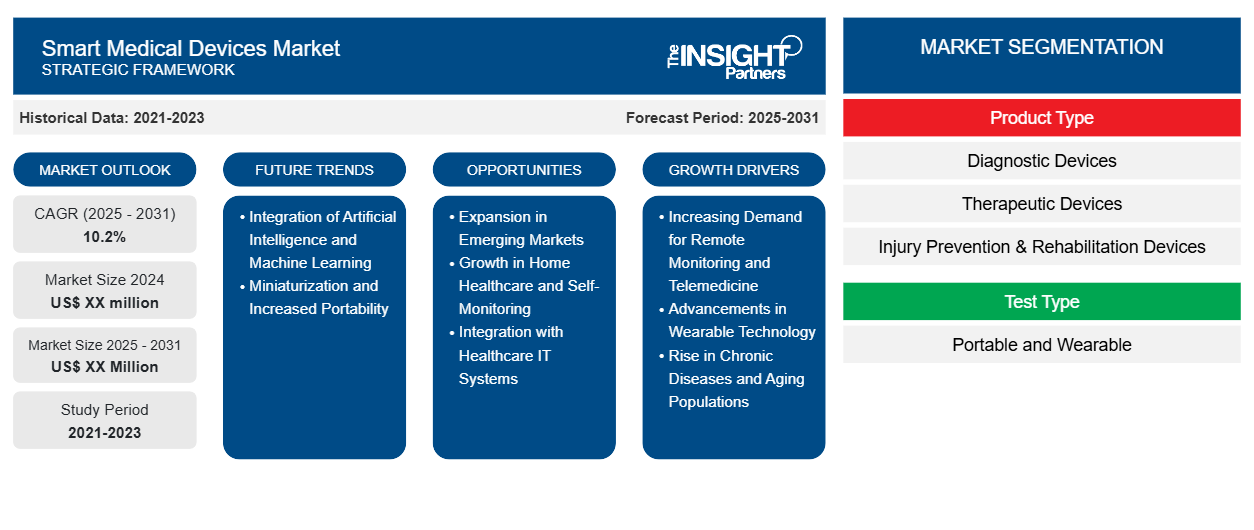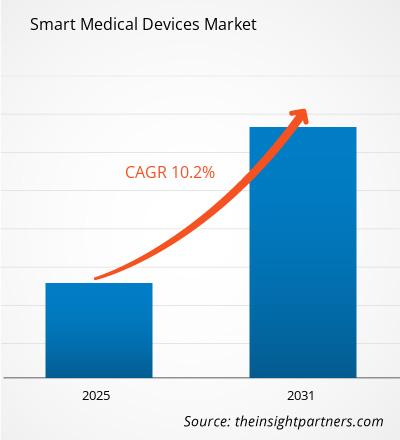スマート医療機器市場は、2024年から2031年にかけて10.2%のCAGRで成長すると予想されており、市場規模は2024年のXX百万米ドルから2031年にはXX百万米ドルに拡大する見込みです。
レポートは、製品タイプ(診断装置、治療装置、傷害予防およびリハビリテーション装置、その他)、テストタイプ(ポータブルおよびウェアラブル)、エンドユーザー(病院および診療所、在宅ケア環境、その他)別にセグメント化されています。レポートでは、上記の分析とセグメントの値を USD で提供しています。
報告書の目的
The Insight Partners のレポート「スマート医療機器市場」は、現在の状況と将来の成長、主な推進要因、課題、機会を説明することを目的としています。これにより、次のようなさまざまなビジネス関係者に洞察が提供されます。
- テクノロジープロバイダー/メーカー: 進化する市場の動向を理解し、潜在的な成長機会を把握することで、情報に基づいた戦略的意思決定が可能になります。
- 投資家: 市場の成長率、市場の財務予測、バリュー チェーン全体に存在する機会に関する包括的な傾向分析を実施します。
- 規制機関: 市場の濫用を最小限に抑え、投資家の信用と信頼を維持し、市場の完全性と安定性を維持することを目的として、市場における政策と警察活動を規制します。
スマート医療機器市場のセグメンテーション
製品タイプ
- 診断装置
- 治療機器
- 傷害予防およびリハビリテーション機器
- その他
テストの種類
- ポータブルでウェアラブル
エンドユーザー
- 病院・クリニック
- ホームケア設定
- その他
地理
- 北米
- ヨーロッパ
- アジア太平洋
- 南米と中央アメリカ
- 中東およびアフリカ
要件に合わせてレポートをカスタマイズする
このレポートの一部、国レベルの分析、Excelデータパックなど、あらゆるレポートを無料でカスタマイズできます。また、スタートアップや大学向けのお得なオファーや割引もご利用いただけます。
- このレポートの主要な市場動向を入手してください。この無料サンプルには、市場動向から見積もりや予測に至るまでのデータ分析が含まれます。
スマート医療機器市場の成長要因
- リモート モニタリングと遠隔医療の需要の増加: 遠隔患者モニタリングと遠隔医療サービスの需要の増加により、スマート医療機器の市場が拡大しています。医療システムが在宅ケア モデルに向けて進化し続けるにつれて、リアルタイム診断機器の必要性は避けられなくなります。このような機器により、慢性疾患の患者は医療システムに簡単に復帰でき、利便性が向上し、患者が受けるサービスと市場も改善されます。
- ウェアラブル技術の進歩: ヘルストラッカー、スマートウォッチ、ECG モニターなどの健康ウェアラブルデバイスの使用により、ヘルスケア分野は大きく変化しました。このようなデバイスは、心拍数、血圧、血糖値などのバイタルサインや健康パラメータを継続的に追跡し、患者が効果的に健康を管理できるようにします。健康目的でこのようなデバイスを着用したいというユーザーの意欲の高まりも、あらゆる臨床現場や消費者市場における市場の成長を促進しています。
- 慢性疾患の増加と人口の高齢化: 糖尿病、心血管疾患、呼吸器疾患、その他の慢性疾患などの慢性疾患管理のリスク要因と高齢化人口が相まって、スマート医療機器の需要が高まっています。これらの機器により、慢性疾患の管理と監視が可能になり、そのような患者の入院頻度を減らし、生活の質を向上させることができます。高齢者人口の人口統計地理は、パーソナライズされた効果的な医療をさらに促進します。
スマート医療機器市場の将来動向
- 人工知能と機械学習の統合: スマート医療機器市場は、AI とその類似の ML の技術によって再形成されつつあります。AI アルゴリズムは、診断と処方の精度の向上だけでなく、病気の進行度や特定の患者に提供すべき治療法の予測も可能にします。AI アルゴリズムにより、デバイスは患者のデータを収集、保存、分析すると同時に、治療オプションの改善のための間隔を空け、治療に向けた提案を行い、医療提供を強化し、1 人の患者への医療提供の可用性とスマートさを向上させることができるため、市場が拡大します。スマート医療機器市場は、AI とその類似の ML の技術によって再形成されつつあります。AI アルゴリズムにより、診断と処方の精度の向上だけでなく、病気の進行度や特定の患者に提供すべき治療法の予測も可能にします。AI アルゴリズムにより、デバイスは患者のデータを収集、保存、分析すると同時に、治療オプションの改善のための間隔を空け、治療に向けた提案を行い、1 人の患者への医療提供の可用性とスマートさを向上させることができるため、市場が拡大します。
- 小型化と携帯性の向上: 医療機器の小型化は、今日のスマート医療機器市場で見られる重要なトレンドの 1 つです。比較的小型で軽量なデバイスは、患者の治療遵守を向上させるとともに、患者の快適性も向上させます。携帯型 ECG やインスリン ポンプなど、サイズが非常に小さいデバイスにより、患者、特に常時ケアが必要な患者や移動中にサービスを必要とする患者にとって、ヘルスケア サービスがはるかに利用しやすくなります。
スマート医療機器市場の機会
- 新興市場への拡大: 特にアジア太平洋地域やラテンアメリカ地域などの新しい地域は、スマート医療機器にとって大きな可能性を秘めています。これらの地域では都市化が進み、医療制度は改善され、健康に対する意識も高まっています。これらはすべて、医療機器のニーズを高める要因です。既存の医療ニーズを満たすシンプルで手頃な価格のスマート デバイスは、これらの地域でスマート医療機器の採用率を高める可能性があります。
- 在宅医療と自己モニタリングの成長: 在宅医療と自己モニタリングは、スマート医療機器市場に大きな利益をもたらす上昇傾向にあります。ウェアラブル心臓モニター、血糖値モニタリング機器、デジタル聴診器により、患者は都合の良いときに自分自身をケアすることができます。遠隔から健康管理する需要が高まるにつれて、家庭での使用のみを目的としたスマートデバイスの範囲は拡大しています。
- 医療 IT システムとの統合: 電子医療記録 (HER) やそのクラウド対応物などの医療施設の情報技術システムと臨床機器の統合により、ビジネス チャンスが生まれます。これらのシステムはデータ統合をサポートし、データの共有、患者の外部監視、リアルタイムの健康状態の更新を可能にして、患者の診断と治療を強化します。これにより、医療サービスの提供における高度なスマート デバイスの目的が促進され、市場での需要が高まります。
スマート医療機器市場の地域別分析
予測期間を通じてスマート医療機器市場に影響を与える地域的な傾向と要因は、Insight Partners のアナリストによって徹底的に説明されています。このセクションでは、北米、ヨーロッパ、アジア太平洋、中東およびアフリカ、南米および中米にわたるスマート医療機器市場のセグメントと地理についても説明します。

- スマート医療機器市場の地域別データを入手
スマート医療機器市場レポートの範囲
| レポート属性 | 詳細 |
|---|---|
| 2024年の市場規模 | XX百万米ドル |
| 2031年までの市場規模 | XX百万米ドル |
| 世界のCAGR(2025年~2031年) | 10.2% |
| 履歴データ | 2021-2023 |
| 予測期間 | 2025-2031 |
| 対象セグメント | 製品タイプ別
|
| 対象地域と国 | 北米
|
| 市場リーダーと主要企業プロフィール |
|
スマート医療機器市場のプレーヤー密度:ビジネスダイナミクスへの影響を理解する
スマート医療機器市場は、消費者の嗜好の変化、技術の進歩、製品の利点に対する認識の高まりなどの要因により、エンドユーザーの需要が高まり、急速に成長しています。需要が高まるにつれて、企業は提供を拡大し、消費者のニーズを満たすために革新し、新たなトレンドを活用し、市場の成長をさらに促進しています。
市場プレーヤー密度とは、特定の市場または業界内で活動している企業または会社の分布を指します。これは、特定の市場スペースに、その市場規模または総市場価値に対してどれだけの競合相手 (市場プレーヤー) が存在するかを示します。
スマート医療機器市場で事業を展開している主要企業は次のとおりです。
- アボットラボラトリーズ
- アップル社
- デクスコム株式会社
- フィットビット株式会社
- F.ホフマン・ラ・ロシュ株式会社
免責事項:上記の企業は、特定の順序でランク付けされていません。

- スマート医療機器市場のトップキープレーヤーの概要を入手
主なセールスポイント
- 包括的なカバレッジ: レポートでは、スマート医療機器市場の製品、サービス、タイプ、エンドユーザーの分析を包括的にカバーし、全体的な展望を提供します。
- 専門家による分析: レポートは、業界の専門家とアナリストの深い理解に基づいてまとめられています。
- 最新情報: このレポートは、最新の情報とデータの傾向を網羅しているため、ビジネスの関連性を保証します。
- カスタマイズ オプション: このレポートは、特定のクライアント要件に対応し、ビジネス戦略に適切に適合するようにカスタマイズできます。
したがって、スマート医療機器市場に関する調査レポートは、業界のシナリオと成長の見通しを解読し理解する道の先導役となることができます。正当な懸念事項がいくつかあるかもしれませんが、このレポートの全体的な利点は欠点を上回る傾向があります。
- 過去2年間の分析、基準年、CAGRによる予測(7年間)
- PEST分析とSWOT分析
- 市場規模価値/数量 - 世界、地域、国
- 業界と競争環境
- Excel データセット


- Green Hydrogen Market
- Medical and Research Grade Collagen Market
- Virtual Event Software Market
- Print Management Software Market
- Identity Verification Market
- Authentication and Brand Protection Market
- Nuclear Decommissioning Services Market
- Smart Grid Sensors Market
- Procedure Trays Market
- Batter and Breader Premixes Market

Report Coverage
Revenue forecast, Company Analysis, Industry landscape, Growth factors, and Trends

Segment Covered
This text is related
to segments covered.

Regional Scope
North America, Europe, Asia Pacific, Middle East & Africa, South & Central America

Country Scope
This text is related
to country scope.
よくある質問
The diagnostic devices segment accounts for highest revenue in product type segment in 2023
The Smart Medical Devices Market is estimated to witness a CAGR of 10.2% from 2023 to 2031
Asia Pacific region dominated the smart medical devices market in 2023
North America region dominated the smart medical devices market in 2023
The major factors driving the smart medical devices market are:
1.Increasing Demand for Remote Monitoring and Telemedicine
2.Advancements in Wearable Technology
3. Rise in Chronic Diseases and Aging Populations
Abbott Laboratories, Apple, Inc., Dexcom, Inc., Fitbit, Inc., F. Hoffman-La-Roche Ltd., Johnson & Johnson, Medtronic, Zephyr, and Sonova are some of the major market players operating in the market
Trends and growth analysis reports related to Life Sciences : READ MORE..
- Abbott Laboratories
- Apple, Inc.
- Dexcom, Inc.
- Fitbit, Inc.
- F. Hoffman-La-Roche Ltd.
- Johnson & Johnson
- Medtronic
- NeuroMetrix, Inc.
- Zephyr
- Sonova
The Insight Partners performs research in 4 major stages: Data Collection & Secondary Research, Primary Research, Data Analysis and Data Triangulation & Final Review.
- Data Collection and Secondary Research:
As a market research and consulting firm operating from a decade, we have published and advised several client across the globe. First step for any study will start with an assessment of currently available data and insights from existing reports. Further, historical and current market information is collected from Investor Presentations, Annual Reports, SEC Filings, etc., and other information related to company’s performance and market positioning are gathered from Paid Databases (Factiva, Hoovers, and Reuters) and various other publications available in public domain.
Several associations trade associates, technical forums, institutes, societies and organization are accessed to gain technical as well as market related insights through their publications such as research papers, blogs and press releases related to the studies are referred to get cues about the market. Further, white papers, journals, magazines, and other news articles published in last 3 years are scrutinized and analyzed to understand the current market trends.
- Primary Research:
The primarily interview analysis comprise of data obtained from industry participants interview and answers to survey questions gathered by in-house primary team.
For primary research, interviews are conducted with industry experts/CEOs/Marketing Managers/VPs/Subject Matter Experts from both demand and supply side to get a 360-degree view of the market. The primary team conducts several interviews based on the complexity of the markets to understand the various market trends and dynamics which makes research more credible and precise.
A typical research interview fulfils the following functions:
- Provides first-hand information on the market size, market trends, growth trends, competitive landscape, and outlook
- Validates and strengthens in-house secondary research findings
- Develops the analysis team’s expertise and market understanding
Primary research involves email interactions and telephone interviews for each market, category, segment, and sub-segment across geographies. The participants who typically take part in such a process include, but are not limited to:
- Industry participants: VPs, business development managers, market intelligence managers and national sales managers
- Outside experts: Valuation experts, research analysts and key opinion leaders specializing in the electronics and semiconductor industry.
Below is the breakup of our primary respondents by company, designation, and region:

Once we receive the confirmation from primary research sources or primary respondents, we finalize the base year market estimation and forecast the data as per the macroeconomic and microeconomic factors assessed during data collection.
- Data Analysis:
Once data is validated through both secondary as well as primary respondents, we finalize the market estimations by hypothesis formulation and factor analysis at regional and country level.
- Macro-Economic Factor Analysis:
We analyse macroeconomic indicators such the gross domestic product (GDP), increase in the demand for goods and services across industries, technological advancement, regional economic growth, governmental policies, the influence of COVID-19, PEST analysis, and other aspects. This analysis aids in setting benchmarks for various nations/regions and approximating market splits. Additionally, the general trend of the aforementioned components aid in determining the market's development possibilities.
- Country Level Data:
Various factors that are especially aligned to the country are taken into account to determine the market size for a certain area and country, including the presence of vendors, such as headquarters and offices, the country's GDP, demand patterns, and industry growth. To comprehend the market dynamics for the nation, a number of growth variables, inhibitors, application areas, and current market trends are researched. The aforementioned elements aid in determining the country's overall market's growth potential.
- Company Profile:
The “Table of Contents” is formulated by listing and analyzing more than 25 - 30 companies operating in the market ecosystem across geographies. However, we profile only 10 companies as a standard practice in our syndicate reports. These 10 companies comprise leading, emerging, and regional players. Nonetheless, our analysis is not restricted to the 10 listed companies, we also analyze other companies present in the market to develop a holistic view and understand the prevailing trends. The “Company Profiles” section in the report covers key facts, business description, products & services, financial information, SWOT analysis, and key developments. The financial information presented is extracted from the annual reports and official documents of the publicly listed companies. Upon collecting the information for the sections of respective companies, we verify them via various primary sources and then compile the data in respective company profiles. The company level information helps us in deriving the base number as well as in forecasting the market size.
- Developing Base Number:
Aggregation of sales statistics (2020-2022) and macro-economic factor, and other secondary and primary research insights are utilized to arrive at base number and related market shares for 2022. The data gaps are identified in this step and relevant market data is analyzed, collected from paid primary interviews or databases. On finalizing the base year market size, forecasts are developed on the basis of macro-economic, industry and market growth factors and company level analysis.
- Data Triangulation and Final Review:
The market findings and base year market size calculations are validated from supply as well as demand side. Demand side validations are based on macro-economic factor analysis and benchmarks for respective regions and countries. In case of supply side validations, revenues of major companies are estimated (in case not available) based on industry benchmark, approximate number of employees, product portfolio, and primary interviews revenues are gathered. Further revenue from target product/service segment is assessed to avoid overshooting of market statistics. In case of heavy deviations between supply and demand side values, all thes steps are repeated to achieve synchronization.
We follow an iterative model, wherein we share our research findings with Subject Matter Experts (SME’s) and Key Opinion Leaders (KOLs) until consensus view of the market is not formulated – this model negates any drastic deviation in the opinions of experts. Only validated and universally acceptable research findings are quoted in our reports.
We have important check points that we use to validate our research findings – which we call – data triangulation, where we validate the information, we generate from secondary sources with primary interviews and then we re-validate with our internal data bases and Subject matter experts. This comprehensive model enables us to deliver high quality, reliable data in shortest possible time.


 このレポートの無料サンプルを入手する
このレポートの無料サンプルを入手する